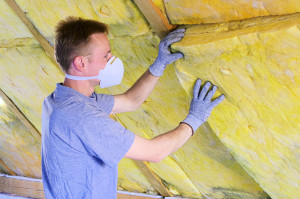
To put it simply, ice dams are caused by an overly warm attic. When indoor air escapes into your attic, it warms the snow accumulated on the roof top allowing the snow to melt enough to turn into water. When the air temperature is low enough, this water freezes at the edge of your roof. Many homeowners tend to think they need a new roof when they get ice dams. In fact, many homeowners reroof their house and still get ice dams.
Before having the roof replaced, check for any gaps in the insulation of your attic. These gaps may be letting the indoor air escape. The easiest way to check your insulation, is to crawl around your attic and look. While you are up there, double check that the insulation covers the top plates of the exterior walls and take a measurement. You should have a minimum of 14 inches of fiberglass, cellulose, or open-cell spray foam. If you have blown-in fiberglass, you should have about 20 inches. Once you ensure your attic is property insulated, you should also check to see that the ventilation from your bathrooms is going outside and not to your attic.
While the focus of this article is to prevent ice dams, we think it is important to note that re-insulating your attic not only saves on your heating bill in the winter; it also saves energy in the summer by helping your home stay cool in the warmer months.
Like in the case of Ice dams, when homeowners feel heat escaping from their roof, they automatically think they need a new roof. This is not always the case, and reinsulating is a lot more affordable than reroofing.



